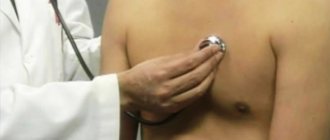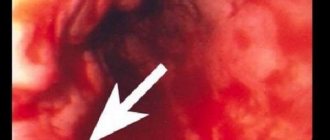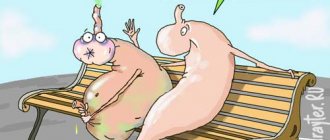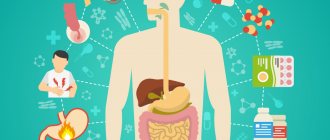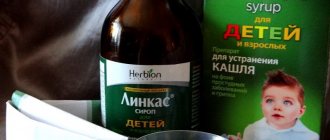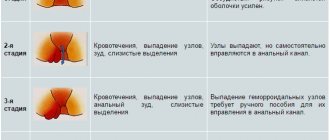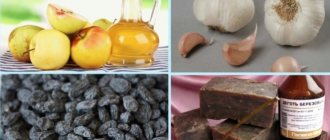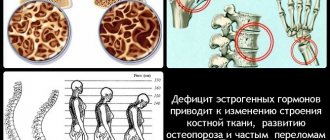Release form, packaging and composition of the drug Clinical-pharmacological group Pharmaco-therapeutic group Pharmacological action Indications for use Method of administration and doses Side effects Contraindications for use Use in children Special instructions Drug interactions
Registration Certificate Holder:
OTCIPHARM, JSC (Russia)
ATX Code:
A02BX05
Active substance:
bismuth tripotassium dicitrate
Dosage form:
Escape
| The drug is approved for use as an over-the-counter product | Escape | Film-coated tablets reg. No.: LP-003299 dated 11/10/15 - Valid |
Release form and composition
The drug is produced in the form of film-coated tablets: biconvex, round, with a faint ammonia odor; shell and core in cross section - from almost white to white (10 or 14 pieces in blisters, 4 or 8 blisters in a cardboard pack and instructions for using Escape).
Composition per 1 tablet:
- active ingredient: bismuth tripotassium dicitrate – 300 mg (corresponds to the content of bismuth oxide – 120 mg);
- auxiliary components: corn starch – 54.22 mg; povidone – 42 mg; polacrilin – 20 mg; magnesium stearate – 3.78 mg;
- film coating: AquaPolish P white 019.49 MS [hydroxypropyl methylcellulose (E464), hydroxypropylcellulose (E463), stearic acid (E570), talc (E553b), polyethylene glycol, titanium dioxide (E171)] – 13 mg.
Instructions
Registration number: Trade name of the drug: Escape® International nonproprietary name or generic name : bismuth tripotassium dicitrate Dosage form: film-coated tablets
Composition per tablet:
Active substance: bismuth tripotassium dicitrate – 300.00 mg, in terms of bismuth oxide – 120.00 mg. Excipients: corn starch - 54.22 mg, povidone (medium molecular weight polyvinylpyrrolidone, povidone K 25) - 42.00 mg, polacrilin (potassium polacrilin) - 20.00 mg, magnesium stearate - 3.78 mg. Shell: AquaPolish® P white 019.49 MS [Hydroxypropyl methylcellulose (E 464) – 7.80 mg; hydroxypropylcellulose (E 463) – 1.30 mg; stearic acid (E 570) – 0.91 mg; talc (E 553b) – 1.30 mg; polyethylene glycol – 0.39 mg; titanium dioxide (E171) – 1.30 mg] – 13.00 mg.
Description
Round, biconvex, film-coated tablets of white or almost white color, with a faint odor of ammonia, white or almost white on the break. Pharmacotherapeutic group: Antiulcer, antiseptic intestinal and astringent. ATX code: [A02ВХ05]
Pharmacological properties
Pharmacodynamics
Gastroprotective and antiulcer agent with bactericidal activity against Helicobacter pylori. It also has anti-inflammatory and astringent effects.
In the acidic environment of the stomach, insoluble bismuth oxychloride and citrate are precipitated, and chelate compounds are formed with the protein substrate in the form of a protective film on the surface of ulcers and erosions. Thus, the drug forms a protective layer, which for a long period of time protects the affected areas of the mucous membrane from the influence of aggressive factors. By increasing the synthesis of prostaglandin E, mucus formation and bicarbonate secretion, it stimulates the activity of cytoprotective mechanisms, increases the resistance of the gastrointestinal mucosa to the effects of pepsin, hydrochloric acid, enzymes and bile salts. Leads to the accumulation of epidermal growth factor in the defect area. Reduces the activity of pepsin and pepsinogen.
Pharmacokinetics
Practically not absorbed from the gastrointestinal tract. It is excreted mainly in feces. A small amount of bismuth entering the plasma is excreted from the body by the kidneys.
Indications for use
- functional dyspepsia not associated with organic diseases of the gastrointestinal tract;
- chronic gastritis and gastroduodenitis in the acute phase, including those associated with Helicobacter pylori;
- peptic ulcer of the stomach and duodenum in the acute phase, including those associated with Helicobacter pylori;
- irritable bowel syndrome, which occurs predominantly with symptoms of diarrhea.
Contraindications
- increased individual sensitivity to the components of the drug;
- pregnancy;
- breastfeeding period;
- taking medications containing bismuth;
- chronic renal failure;
- children under 4 years of age.
Use during pregnancy and breastfeeding
Bismuth tripotassium dicitrate is contraindicated for use in pregnant women. If it is necessary to use the drug during lactation, breastfeeding should be stopped.
Directions for use and doses
Inside. The duration of the course of treatment and the dose of the drug are determined by the attending physician individually for each patient, depending on the nature of the disease.
For adults and children over 12 years of age, the drug is prescribed 1 tablet 4 times a day, 30 minutes before meals (breakfast, lunch, dinner) and at night, or 2 tablets 2 times a day 30 minutes before meals (breakfast, dinner).
Children aged 8 to 12 years are prescribed 1 tablet 2 times a day 30 minutes before meals (breakfast, dinner).
Children aged 4 to 8 years are prescribed a dose of 8 mg/kg/day; Depending on the child’s body weight, 1-2 tablets are prescribed per day (respectively, in 1-2 doses per day). In this case, the daily dose should be as close as possible to the calculated dose (8 mg/kg/day).
The tablets are taken 30 minutes before meals with a small amount of water.
It is recommended to swallow the tablet whole, without chewing or crushing, with a sufficient amount of water. It is not recommended to take the tablets with milk. The duration of treatment is usually from 4 to 8 weeks. After finishing taking the drug, it is not recommended to take medications containing bismuth (for example, Vikalin, Vikair) for 2 months.
To eradicate Helicobacter pylori, it is advisable to use Bismuth tripotassium dicitrate in combination with antibacterial drugs that have anti-Helicobacter activity.
Side effects
The following adverse events noted with the use of bismuth tripotassium dicitrate are distributed according to the frequency of occurrence in accordance with the following gradation: very often (≥ 1/10); often (≥ 1/100, < 1/10); uncommon (≥ 1/1000, < 1/100); rare (≥ 1/10,000, < 1/1,000); very rare (<1/10,000).
From the gastrointestinal tract: very often - black stool; uncommon – nausea, vomiting, diarrhea or constipation.
Allergic reactions: infrequently - skin rash, itching; very rarely - anaphylactic reactions.
From the nervous system: very rarely - with prolonged use in high doses
- encephalopathy associated with the accumulation of bismuth in the central nervous system.
Side effects are reversible and disappear quickly after discontinuation of the drug.
Overdose
When using the drug in doses tens of times higher than recommended, or with prolonged use of excessive doses of the drug, bismuth poisoning may develop.
Symptoms: dyspepsia, rash, inflammation of the oral mucosa, characteristic darkening in the form of blue lines on the gums; with long-term use in doses exceeding the recommended ones, renal function may be impaired.
These symptoms are completely reversible when the drug is discontinued.
Treatment: there is no specific antidote. In case of an overdose of the drug, gastric lavage, intake of enterosorbents and symptomatic therapy aimed at maintaining kidney function are indicated. In case of overdose, the administration of saline laxatives is also indicated. Further treatment should be symptomatic. In case of impaired renal function, accompanied by a high level of bismuth in the blood plasma, complexing agents – dimercaptosuccinic and dimercaptopropanesulfonic acids – can be administered. With the development of severe renal dysfunction, hemodialysis is indicated.
Interaction with other drugs
For half an hour before and half an hour after taking the drug, it is not recommended to take other medications internally, as well as take food and liquids, in particular antacids, milk, fruits and fruit juices. This is due to the fact that when taken orally simultaneously, they can affect the effectiveness of bismuth tripotassium dicitrate.
The drug reduces the absorption of tetracyclines.
The drug is not used simultaneously with other drugs containing bismuth, since the simultaneous use of several bismuth drugs increases the risk of side effects, including the risk of encephalopathy.
special instructions
The drug should not be used for more than 8 weeks. It is not recommended to exceed the established daily doses for adults and children during treatment. During treatment with the drug, you should not use other drugs containing bismuth (see section “Interaction with other drugs”). At the end of a course of treatment with the drug in recommended doses, the concentration of the active substance in the blood plasma does not exceed 3 - 58 mcg/l, and intoxication is observed only at concentrations above 100 mcg/l.
When using bismuth tripotassium dicitrate, stool may turn dark due to the formation of bismuth sulfide.
Sometimes there is a slight darkening of the tongue. Alcohol consumption is not recommended during therapy.
Effect on the ability to drive vehicles and machines There is no data on the effect of Escape® film-coated tablets on the ability to drive vehicles and machines.
Release form
Film-coated tablets, 120 mg.
10 or 14 tablets in a blister pack made of polyvinyl chloride film and printed varnished aluminum foil.
4 or 8 blister packs along with instructions for use are placed in a cardboard pack.
Storage conditions
Store at a temperature not exceeding 25 °C. Keep out of the reach of children.
Best before date
2 years. Do not use after the expiration date stated on the packaging.
Vacation conditions
Over the counter.
Marketing authorization holder/organization receiving consumer complaints
PJSC OTCPharm, Russia, 123317, Moscow, st. Testovskaya, 10 Tel.: +7 (800) 775-98-19 Fax www.otcpharm.ru
, 305022, Russia, Kursk, st. 2nd Aggregatnaya, 1a/18, tel./fax www.pharmstd.ru
Pharmacological properties
Pharmacodynamics
Escape is a gastroprotective and antiulcer drug that exhibits bactericidal activity against Helicobacter pylori, with an astringent and anti-inflammatory effect.
The active substance of Escape, bismuth tripotassium dicitrate, is precipitated in the acidic environment of the stomach in the form of insoluble bismuth compounds - oxychloride and citrate, which form chelates with a protein substrate, representing a protective film on ulcerative and erosive surfaces. A protective layer is formed that protects the affected mucous membrane from the effects of aggressive factors for a long time.
Bismuth tripotassium dicitrate increases the synthesis of prostaglandin E, improves mucus secretion and the formation of bicarbonate, potentiates the activity of cytoprotective mechanisms, increases the resistance of the gastrointestinal mucosa to pepsin, hydrochloric acid, enzymes and bile salts. In the area of ulceration it leads to the accumulation of epidermal growth factor. Inhibits the activity of pepsin and pepsinogens.
Pharmacokinetics
Bismuth tripotassium dicitrate is almost not absorbed from the gastrointestinal tract.
Bismuth is excreted mainly in feces; a small amount of the substance entering the plasma is eliminated by the kidneys.
pharmachologic effect
Gastroprotective and antiulcer agent with bactericidal activity against Helicobacter pylori. It also has anti-inflammatory and astringent effects.
In the acidic environment of the stomach, insoluble bismuth oxychloride and citrate are precipitated, and chelate compounds are formed with the protein substrate in the form of a protective film on the surface of ulcers and erosions. Thus, the drug forms a protective layer, which for a long period of time protects the affected areas of the mucous membrane from the influence of aggressive factors. By increasing the synthesis of prostaglandin E, the formation of mucus and the secretion of bicarbonate, it stimulates the activity of cytoprotective mechanisms, increases the resistance of the gastrointestinal mucosa to the effects of pepsin, hydrochloric acid, enzymes and bile salts. Leads to the accumulation of epidermal growth factor in the defect area. Reduces the activity of pepsin and pepsinogen.
Practically not absorbed from the gastrointestinal tract. It is excreted mainly in feces. A small amount of bismuth entering the plasma is excreted from the body by the kidneys.
Escape: instructions for use (dosage and method)
Escape film-coated tablets are taken orally 30 minutes before meals and washed down with a sufficient amount of water. They should be swallowed whole, without crushing or chewing. It is not recommended to take tablets with milk.
The duration of the course of therapy and dose are determined individually by the attending physician, depending on the nature and clinical course of the disease.
Standard dosage of Escape - depending on the age of the patient, tablets are taken as follows:
- children over 12 years old and adults: 1 pc. 4 times a day, before breakfast, lunch, dinner (30 minutes before meals) and before bed, or 2 pcs. 2 times/day 30 minutes before breakfast and dinner;
- children from 8 to 12 years old: 1 pc. 2 times/day 30 minutes before breakfast and dinner;
- children from 4 to 8 years: at a dose of 8 mg/kg per day, which, depending on the child’s body weight, is 1 or 2 pieces. (respectively, in 1 or 2 doses). The daily dose should be closest to the calculated one.
As a rule, the therapeutic course lasts from 4 to 8 weeks. After completion of treatment, it is not recommended to take products containing bismuth (Vicair, Vikalin, etc.) for 2 months.
To eradicate Helicobacter pylori, bismuth tripotassium dicitrate is used in combination with antibiotics that have anti-Helicobacter activity.
Instructions for use
The components of this product have increased activity against the bacteria Helicobacter Pylori. The method of using Escape is described in detail in the instructions. The manufacturer not only explains the composition of the drug and its pharmacological effect on the body, but also provides a list of recommended indications and contraindications for prescribing this medication.
pharmachologic effect
Escape's action is aimed at suppressing the activity of Helicobacter pylori bacteria. These microorganisms are becoming one of the most common causes of the development of pathological processes associated with impaired functioning of the gastrointestinal tract.
A course of Escape allows you to create a specific protective barrier that not only prevents the negative effects of external factors, but also prevents the destruction of mucous membranes by bile salts and hydrochloric acid.
Properties of the drug:
- bactericidal effect against the bacterium Helicobacter pylori;
- decreased pepsin activity;
- astringent effect (eliminates some types of pain);
- slowing down inflammatory processes in the digestive system;
- increased synthesis of prostaglandin E;
- stimulation of the activity of cytoprotective mechanisms;
- increased secretion of bicarbonate and mucus secretion;
- formation of protective films on the surface of erosions;
- stimulating the regeneration of damaged cells;
- acceleration of the tendency to recovery in inflammatory processes in the gastrointestinal tract;
- reducing the intensity of intestinal irritation.
Indications for use
Escape is prescribed for:
- functional dyspepsia not associated with organic gastrointestinal diseases;
- duodenal and gastric ulcers in the acute phase (including those associated with Helicobacter pylori);
- chronic gastritis, gastroduodenitis in the acute phase (including those associated with Helicobacter pylori);
- irritable bowel syndrome, which occurs predominantly with signs of diarrhea.
Mode of application
The manufacturer recommends taking Escape internally. The dosage of the drug and the duration of treatment are determined individually for each patient, based on the clinical picture of the disease.
The tablets are taken before meals (half an hour before it) and washed down with water. Swallow the tablet whole, without first crushing/chewing. It is not recommended to take the drug with milk.
Recommended doses:
Children over 12, adults: 1 tablet four times a day or 2 tablets twice a day.- Children from 8 to 12: 1 tablet twice a day (before breakfast, dinner).
- Children from 4 to 8: 8 mg/kg/day. Depending on the patient’s weight, 1-2 tablets of the drug per day are prescribed (in 1-2 doses per day). It is important that the daily dose is close to the calculated dose (respectively 8 mg/kg/day).
Typically, the duration of treatment varies from 4 to 8 weeks . After completion of therapy, it is not recommended to take drugs containing bismuth (Vicair, Vikalin, etc.). This restriction is valid for 60 days from the end of Escape.
It is advisable to prescribe bismuth tripotassium dicitrate together with antibacterial drugs that have anti-Helicobacter activity (for the eradication of Helicobacter pylori).
Release form, composition
Escape is supplied to pharmacies in the form of biconvex tablets coated with a white (or almost white) film coating. The tablets have a faint ammonia odor. The color on the break is white or close to white. Tablets of 14 or 10 pieces are placed in blister packs made of printed varnished aluminum foil and polyvinyl chloride film. Cellular packages of 4 or 8 pieces are placed in cardboard packs.
The drug contains bismuth tripotassium dicitrate (active component) and auxiliary ingredients - corn starch, polacrilin, povidone, magnesium stearate.
Interaction with other drugs
Escape reduces the absorption of tetracyclines.
The drug should not be used in combination with other drugs containing bismuth. The simultaneous use of two or more bismuth preparations increases the risk of side effects (for example, encephalopathy).
The oral use of other medications is not recommended for 30 minutes before and 30 minutes after consuming Escape. The same goes for liquids and food, particularly fruit, milk, fruit juice and antacids.
Side effects
While taking Escape, the following side effects may develop (mostly reversible and quickly disappear after discontinuation of the drug):
- Gastrointestinal tract: very often – black stool; uncommon – nausea/vomiting, diarrhea or constipation;
- immune system: uncommon – itching, skin rash; extremely rarely - anaphylaxis;
- CNS (central nervous system): extremely rarely (with long-term use of high doses) - encephalopathy caused by the accumulation of bismuth in the central nervous system.
Overdose
The use of Escape in doses tens of times higher than recommended, or prolonged use of excessive doses, can lead to bismuth poisoning.
Symptoms of an overdose of bismuth tripotassium dicitrate are rash, dyspepsia, inflammation of the oral mucosa, and specific (in the form of blue lines) darkening of the gums. As a result of long-term use in doses exceeding the recommended ones, renal dysfunction may develop. Symptoms go away on their own after discontinuation of the drug.
If bismuth intoxication is established, the patient needs to rinse the stomach, give enterosorbents, and, if necessary, carry out symptomatic treatment aimed at maintaining kidney function. In case of overdose, it is also recommended to take saline laxatives. For the treatment of impaired renal function, accompanied by high plasma concentrations of bismuth, complexing agents are prescribed - dimercaptopropanesulfonic and dimercaptosuccinic acids. In case of severe renal impairment, hemodialysis is prescribed. The specific antidote for bismuth tripotassium dicitrate is currently unknown.
special instructions
The duration of Escape should not exceed 8 weeks.
During therapy, it is not recommended to exceed the established daily doses for children and adults.
You should not use other medications containing bismuth during treatment with Escape. Upon completion of the therapeutic course (if taken in recommended doses), the concentration of bismuth in the blood plasma varies from 3 to 58 mcg/l. However, intoxication is observed when the level of bismuth in plasma is 100 µg/l and above.
Taking bismuth tripotassium dicitrate may turn stool dark due to the formation of bismuth sulfide. Some patients experience slight darkening of the tongue.
Drinking alcoholic beverages during therapy is not recommended.
Impact on the ability to drive vehicles and complex mechanisms
No data.
Directions for use and doses
The method of administration and dosage regimen of a particular drug depend on its release form and other factors. The optimal dosage regimen is determined by the doctor. The compliance of the dosage form of a particular drug with the indications for use and dosage regimen should be strictly observed.
Adults and children over 4 years old - orally 2-4 times a day 30 minutes before meals. The dose depends on the patient's age.
The course of treatment is 4-8 weeks. You should not take medications containing bismuth for the next 8 weeks.
For eradication
Helicobacter pylori, it is advisable to use bismuth tripotassium dicitrate in combination with antibacterial drugs with anti-Helicobacter activity.
Drug interactions
Any other oral medications, as well as food and liquids (including antacids, milk, fruit and fruit juices) are not recommended to be taken within half an hour before or after Escape, as they may affect the Escape if taken concomitantly with Tripotassium Bismuth Dicitrate. efficiency.
Bismuth reduces the absorption of tetracyclines.
It is important to avoid using Escape concomitantly with other medicines containing bismuth. This is due to the fact that taking several bismuth preparations at the same time increases the risk of developing negative side reactions, including encephalopathy.
Reviews about Escape
According to reviews, Escape is an excellent remedy for exacerbations of chronic gastritis, enteritis, and colitis. It quickly and effectively relieves stomach pain, nausea and heartburn. Relief occurs almost after the first dose. Patients note the adequate cost of the drug and its availability in pharmacies.
In rare cases, they complain about the lack of the expected effect, which, according to users, turns out to be weaker than some analogues. They also consider the dosing regimen inconvenient, since the tablets have to be taken 4 times a day.
